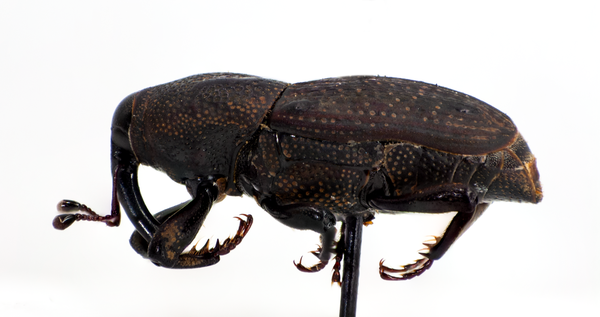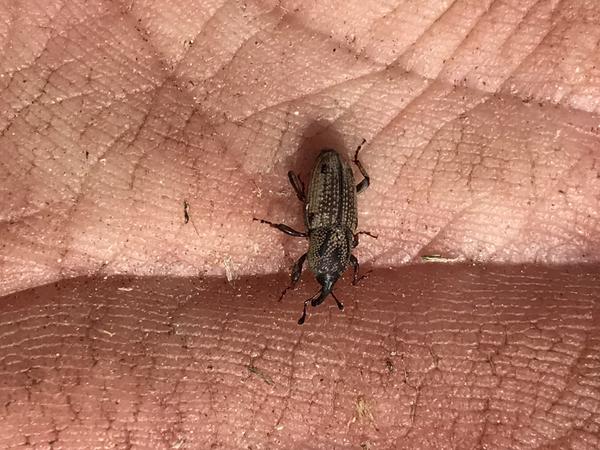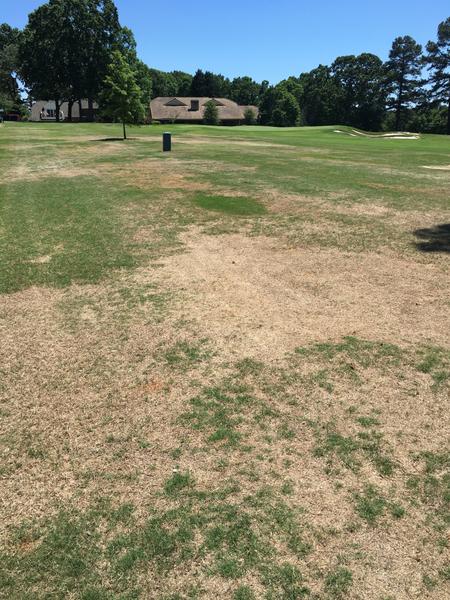Description
Hunting billbug adults measure 0.3-0.4 inches in length and are black, charcoal gray, or brownish in color (Figure 1). The distinguishing characteristic for this species is a smooth, non-punctated Y-shaped area behind the head and parenthesis-like curved markings on the sides of the pronotum (Figure 2). They usually overwinter as adults or as partially mature larvae in the thatch, soil crevices, under mulch or leaf litter. The adults emerge from their overwintering sites as temperatures increase in the spring and will feed and mate. They are active at night and will feign death when disturbed. Damage by adults is most prominent in spring, but can also be seen in the fall (Figure 3). The adults will lay oblong, creamy white eggs from May into September. The eggs take 3-10 days to hatch. The larvae that hatch are white, legless and have a brown head capsule; they feed on the turfgrass stems and as they mature the crown, roots, and stolons. Larvae are most common from May to October. At full maturity, 3-5 weeks after egg hatch, the larvae measure 0.2-0.4 inches in length. They will then pupate in the soil and 3-7 days later the adult hunting billbug emerges.
Chemical Control
To control adult populations apply insecticides in spring when adults emerge from their overwintering sites, but before they lay their eggs. Treat no later than 3 weeks after adults become active. The use of insecticides for adult control includes bifenthrin (Talstar, Menace, etc), deltamethrin (Deltagard), lambda-cyhalothrin (Scimitar or Battle), or imidacloprid (Merit). The use of insecticides for larval control includes clothianidin (Arena) or thiamethoxam (Meridian). The use of insecticides for both adults and larval control include chlorantraniliprole (Acelepryn), clothianidin + bifenthrin (Aloft), or imidacloprid + bifenthrin (Allectus, Atera). Check the label for rates and application methods. Applications in the spring are preventative and should only be made on sites with a history of hunting billbugs. To control larval populations apply insecticides 6 weeks after the adults become active. At this point the larvae are in the root zone and are the most vulnerable. Be sure to water the insecticide in after application to insure insecticide movement through the thatch.
| Insecticide and Formulation | Amount per 1,000 sq ft | Precaution and Remarks |
|---|---|---|
| bifenthrin* (Menace, Talstar, others) F, GC; G form also available | 0.25 to 0.5 fl oz | Use GC formulation for golf courses. |
| chlorantraniliprole (Acelepryn) | 0.184 to 0.46 fl oz | |
| chlorpyrifos* (Dursban) 50 WSP, Pro | See label | For use on golf courses; check new label. |
| clothianidin (Arena) .5G 50 WDG | 14 to 22 oz 0.15 to 0.22 oz | |
| chlothianidin + bifenthrin (Aloft) GC SC LC SC GC G LC G | See label 0.27 to 0.44 fl oz 0.27 to 0.54 fl oz 1.8 to 3.6 lb 1.8 to 3.6 lb | |
| deltamethrin (Deltagard) G | 2 to 3 lb/1,000 ft | |
| imidacloprid* (Merit) 75 WSP | 3 to 4 level tsp | Make application prior to egg hatch. |
| imidacloprid + bifenthrin (Allectus, Atera) | See label | Rate varies with pest. Different formulations for different sites. |
| lambda-cyhalothrin* (Battle, Scimitar, Cyonara) | See label | Observe restrictions near water. |
| propoxur (Baygon) 1.5 fl oz | 1 pt | Treat area thoroughly. Use at least 15 gallons water per 1,000 sq ft. Do not allow spray mixture to stand overnight. Mow grass before treatment. |
| thiamethoxam (Meridian) 0.33 G 25 WG | 60 to 80 lb/acre 12.7 to 17 oz/acre | Optimum control when applied from peak flight of adults to peak of egg hatch. Also suppresses mole crickets and chinch bugs. |
| Dinotefuran (Zylam) 20SG | 1 oz per 1000 ft2 |
References
- Common name: hunting billbug, scientific name: Sphenophorus venatus vestitus Chittenden (Insecta: Coleoptera: Curculionidae). Robert E. Woodruff, R. E. 2005 (revised). Featured Creatures. Entomology & Nematology, FDACS/DPI, EDIS. Publication EENY-207.
- Hunting Billbug: An Emerging Pest of Texas Turfgrass. Reinert, J. and B. M. Drees. 2011. Texas A&M AgriLife Extension, Landscape IPM.
- 2018 Pest Control for Professional Turfgrass Managers. Bowman, D. et al. 2017. NC State Extension Publication AG-408. 81 pp.
- Extension Plant Pathology Publications and Factsheets
- Horticultural Science Publications
- North Carolina Agricultural Chemicals Manual
For assistance with a specific problem, contact your local Cooperative Extension Center
Publication date: Oct. 25, 2017
Recommendations for the use of agricultural chemicals are included in this publication as a convenience to the reader. The use of brand names and any mention or listing of commercial products or services in this publication does not imply endorsement by NC State University or N.C. A&T State University nor discrimination against similar products or services not mentioned. Individuals who use agricultural chemicals are responsible for ensuring that the intended use complies with current regulations and conforms to the product label. Be sure to obtain current information about usage regulations and examine a current product label before applying any chemical. For assistance, contact your local N.C. Cooperative Extension county center.
N.C. Cooperative Extension prohibits discrimination and harassment regardless of age, color, disability, family and marital status, gender identity, national origin, political beliefs, race, religion, sex (including pregnancy), sexual orientation and veteran status.



